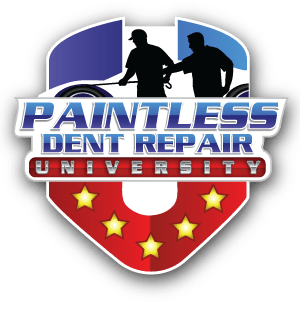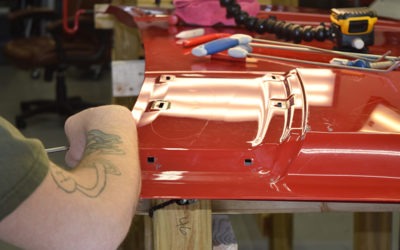I have gone to body shops across the country over the last 18 years. I have seen many sets of abandoned PDR tools sitting on shelves or in corners of collision repair centers. I have heard all of the reasons technicians give why paintless dent repair cannot be learned. Why have they been unable to learn PDR by themselves? As a seasoned PDR Industry master trainer for 16 years, I see 4 main reasons body shop technicians need help learning PDR.
- To Learning Proper Theory
- Be Coached on Proper Technique
- Understand Proper Equipment
- Develop A Proper PDR Mindset
What’s Been Tried And Failed
Body Shop managers, owners, and individual technicians have bought the PDR tools. The technicians have watched the PDR training videos or YouTube videos. They expected to learn these PDR skills. They may even have gone to a training “mill” out in California or hired a PDR technician to “train” PDR. Yet, the tools sit in the back of the shop or on a shelf, never to be used again. Everyone gives the sad story of not being able to learn PDR. If any group should be able to learn and perform PDR, it is the collision repair industry.
An Educator’s Perspective
I come from a teaching family and have taught various subjects over the years. As an example, I have taught golf since I was 12 years old. Part of my family’s gift is to look at systems and processes to understand how they work. Then, if need be, fine-tune or fix them. Paintless dent repair is no different. For years, I have been instructing students, many body shop techs, and their success has come from learning and mastering these four areas. Also, I have seen how improper understanding and implementation of any one of these components usually leads to failure. The only analogy that I can compare it to is a four-legged stool. A broken leg leads to an unusable stool. Likewise, any weak component of the four leads to failure. Thus, the tools are collecting dust.
Learning Proper Theory
The foundational part of paintless dent repair is PDR theory. PDR theory has evolved as technology and innovation have developed in the paintless dent repair industry. The PDR theory today is quite different than even 5 years ago. Innovation continues to develop the PDR theory. An example is last year’s release of a new theory to repair creased dents. Today’s PDR theory is easier to understand, learn, and master than before.
The educational source of PDR theory is where I see a major issue in today’s PDR learning environment. It directly affects the body shop tech’s ability to learning PDR. The main sources body shop technicians are using to learning PDR theory have an over 95% failure rate. Let’s look at these sources:
PDR Training Videos
The technicians are learning PDR theory from DVDs produced in the 1990s that come with most tool kits. These videos are so bad that, back in the day, we were told by the PDR masters to forget everything from the videos. But not all videos are bad. An example is the Dent Trainer videos, which provide a good supplementary background or reinforcement training.
YouTube
YouTube has been a major source of trying to learn PDR. Again, most videos are not produced by actual instructors, and they have been teaching PDR theory for years. I even caught some current trainers I have caught on YouTube speaking old PDR theory, but performing current PDR theory. Plus, the difficulty with videos as a training tool is the difficulty of learning 3-dimensional theory from a 2-dimensional source. The two-dimensional training aids of videos only give you part of the picture. Compounding the confusion is a 2-minute video showing a repair taking hours to perform by a master technician. Wow, it looks so easy…Not! Videos have their place, but not for initial training.
PDR Mill Schools
The PDR “Mill” schools in California, such as Ding King, Rightlook, and Superior Auto Institute, teach PDR theory from the early 90s. Even Ding King’s current promo video, which they sent out, was from the 90s, and the dent guy in the video is retired! The reason they still teach “old school” theory is that they are marketing companies, not paintless dent repair companies. They have no connection with the PDR industry. The owners are not PDR master techs or PDR master instructors. They do not have them on their staff. They are simply companies selling a product/service, so they do not know any different. They are clueless about recent PDR theory advancements and why. Consequently, they continue to teach old PDR theory, and their students continue to fail. I understand this because I retain many of their students.
All the Industry PDR trainers all know each other. It’s a very small cadre of master instructors. We usually meet once a year, sharing the latest PDR industry trends to implement in our training. This year, we are implementing the new 3D lenses for our LED lights in the training environment. A major assistance for students. Do the “mill’ trainers implement innovation in their training? No, they are not even at the table!
Coached on Proper Technique
The DIY system of learning lasts roughly three days. A tech watches the videos, then gets the tools out, sets up a training stand, and then makes some dents. Three days later, the tech is pulling his hair out, throwing tools, and usually gives up. Some of the more determined ones make it a little longer, but the results are the same. The tools go on a shelf, the video disappears in a drawer or in a desk, and the tech goes back to bodywork.
Why? Because the act of performing paintless dent repair skills is very unnatural. The PDR skills and body movements, most of the time, are fighting against natural body movements. Plus, you are using and putting extreme pressure on muscle groups that are rarely used.
A coach must be present to assist the student in proper form and skill development. He must be present, over the shoulder, and guiding the movements of students while they are learning PDR skills. As the body wants to avoid PDR movements, He is there to retrain and redirect the student to perform PDR efficient body movements. This is critical in the first week of training. Most DIY PDR students throw down the tools at this stage, give up, and walk away! You need a coach to learn PDR!
Understanding Proper Equipment
Tools are a big part of performing PDR. You can have the other three components, but if the tools are inferior, then PDR fails. Most sets that I have seen on body shop shelves over the years have been inferior. Lack of knowledge and cost of quality tools has resulted in poor tool purchases that reinforce the body shop tech PDR failure rate. Below are two sets of PDR tools marketed by Auto Body Toolmart. This catalog is in most body shops. Both are inferior, of low quality, and antiquated designs. The 55-piece set is an early 1990s design and not user-friendly with current PDR theory. The DentFix 33-piece set is totally unusable! The Chinese took pictures of old tools and then over-exaggerated the tool sizes and thickness to compensate for poor-quality metal. Even the PDR tools sold on the Snap-On trucks are of poor quality. No PDR techs are going to buy Snap-On PDR tools.
Only high-quality spring or stainless steel that is heat-treated can withstand the torque and pressure we put on PDR tools to push dents out. PDR tools made with inferior material bends are not usable. Along with poor materials, the tool designs are out of date. But, body shops are buying these sets, not knowing good from the bad.
There are only a handful of PDR tool companies, and they are only known in the PDR industry circles. An example of a high-quality PDR tool set that many technicians own, including myself, a Master Craftsman, is the A-1 PDR tool 53-piece premium toolset. The price for this PDR industry-manufactured set is $1145.00. The inferior Auto Body Toolmart set is $1499.96. So, price is not the issue; it’s knowledge of quality tools. We use tools from the 5 major manufacturers in class and extensively train all aspects of PDR tools and equipment. Just as an aside, don’t go to a trainer who forces you to buy their tools. Learn about them first and make an informed tool purchase.
Developing Proper PDR Mindset
Learning the PDR “Feel” is like a body man developing his “Feel”. The body man “Feels” the exterior couture of a panel, examining the surface to check for and repair damage. Both are not learned overnight! But, for years, technicians, managers, and owners have misunderstood the PDR mindset and learning curve. For the most part, body technicians work from the exterior of a panel. The frustrating part of PDR is the aspect of working from behind the panel while viewing from the exterior in a reflection. A complete opposite change in mindset. A proper PDR “feel” and mindset are only developed through repetition. Expectations need to adjust to a longer learning curve. We can teach the PDR mindset in a very short period of time. But for it to become a habit, just like the body man touch, it must be much longer.
The solution is to get repetitions fixing dents. This must be focused time with no distractions. Most quality trainers will recommend two weeks or longer with a dedicated trainer. Typically, nobody wants to take the time or expense for more than a week. Individuals not from the collision repair industry, I refuse to train under a two-week time period. Why? It takes at least two weeks of pushing dents for proper muscle memory to develop! If the “feel” is not developed, then the time and money were all wasted.
The Bottom Line
The bottom line is that a deficiency in any one of these components leads to PDR learning failure. Body Shop Technicians need help learning PDR to get all these components correct. In my opinion, a good PDR industry master instructor is required to become successful at PDR. Do your research into PDR training. I have a guide to choosing PDR training, which you can follow to assist in choosing quality training. I am not saying you have to come to my training. There are a few other trainers out there that will set you on the path of success. I can give you their names since I know all of them. The point is…get quality hands-on PDR training!

